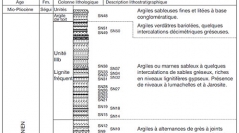

 Geodiversitas
34 (2) - Pages 445-456
Geodiversitas
34 (2) - Pages 445-456In northeastern central Tunisia, the microbasins that appeared under the effect of the Miocene tectonics are infilled by silicoclastic, molassic and fluviodeltaïc deposits. Moreover, phytogenic materials show a paralic characteristic. Palynological study of type locality of the Saouaf Formation seems very useful. This series has been the subject of a palynological study which concluded on vegetation dynamics and thus, on the evolution of paleoenvironments and paleoclimate of the region during the Miocene. We deduced an assemblage of well-preserved and varied palynomorphs. Open vegetation is well defined all along the series with, however, a predominance of spores at the base, indicating the high energy and/or proximity of the source of supply and ground cover rather wooded (mainly Pinaceae) that characterizes the middle part of this series. The evolution of ecological groups predefined along the series of Miocene sedimentary of Saouaf syncline reflects a subtropical climate that gradually evolves into a hot and arid climate. A typical Mediterranean climate seems to settle at the top of series. A comparison with other Tunisian and Mediterranean localities demonstrates that our results enrol in the general climactic context known for the Miocene of Mediterranean, in return for some local specificities and a certain delay in relation to the European regions (a post Langhian cool and setting up of a Mediterranean-type climate in Tortonian). However, a small specificity is observed in Tunisia.
Palynology, paleoenvironment, paleoclimate, Miocene, Saouaf, Tunisia